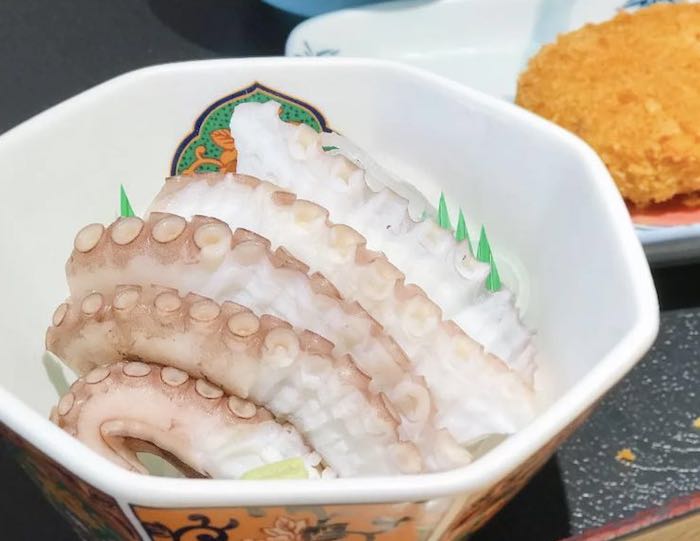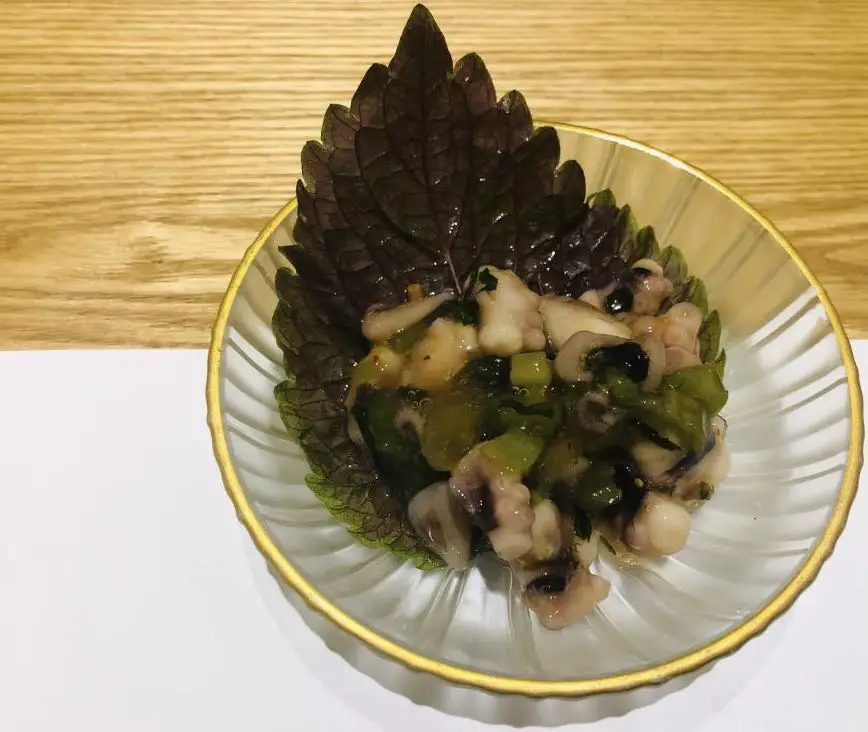We are reader supported. When you purchase through links on our site, we may earn an affiliate commission. Also, as an Amazon affiliate, we earn from qualifying purchases.

Just when I thought I had tried almost all types of sushi that can be possibly made, I came across Tako Sushi (pronounced as TA-ko-su-shee). It sounded a bit different and feeling a bit experimental, I decided to give it a try!
As I sat waiting for the sushi, I had no idea what was going to come to the table until the chef told me it was cooked octopus. From that moment, I have been a fan of taco sushi.
Contents
What Is Tako?
Tako may sound like the popular Mexican dish ‘taco’, but a Japanese Tako is different. Tako is the Japanese term for Octopus and considering the fact that Japan is an island country surrounded by several water bodies, it’s not unnatural for their food culture to include different types of seafood.
Although Tako sushi may not be a common option in the menu of sushi restaurants around the world, it is an extremely popular delicacy in Japan. This style of sushi can be easily identified by its rare appearance – rich purple side skin, white meat, and suction cups.
Those who have not tried Tako before may find it daunting due to its chewy texture and unique looks, but those who have developed a taste for it just can’t have enough.
Unlike other species of seafood and fish, an octopus is always boiled before consumption, even in Japan. This is to bring out the savory flavors and tenderize the meat, which would otherwise taste bland and rubbery.
Interesting Facts about Tako (Octopus)
Although rarely used in sushi restaurants in western countries, Tako (Octopus) is a special ingredient used in Japanese food culture. There are more than 250 various species of octopus with nearly 60 different types caught in and around Japan.
In Japanese food culture, the most common species of octopus used in sushi and salads are known as ‘Madako’ or the common octopus. Surprisingly, the
Another popular species of octopus that is widely consumed is known as ‘iidako’, meaning webfoot octopus. This species is about 10 inches in length and it is usually found in the Japanese waters, the Korean peninsula, and the East China Sea.
Contrary to popular belief, an octopus is rarely eaten raw because it is too chewy. When you purchase tako (octopus) in Japan, it usually comes pre-boiled. Due to this, the octopus skin takes on a bright purple/ red hue and the meat turns white.
Although most of the octopus available for consumption is fished in the Mediterranean and Asian waters, it is usually prepared and processed in Japan. The meat of Octopus has a short life span and they don’t accumulate mercury like other predatory fish. They make a low-calorie meal.
What Are The Interesting Ways Of Cooking Tako (Octopus)
There are numerous superstition and logic associated with the way octopus is prepared around the world. A traditional Greek chef may beat it against rocks while a contemporary one may tell you to throw it four times in the kitchen sink.
The chefs in Span believe that octopus should only be cooked in a copper pot and dipped into boiling water at least three times to make it edible. An Italian chef may insist on cooking the octopus meat with two corks.
The Japanese chefs prefer to rub the tako with salt to get rid of the sliminess and then knead it with grated horseradish. The legs are then cut and sliced in varying angles to get perfect pieces for sushi and other delicacies.
How To Make Tako (Octopus) Sushi At Home
If life gives you the opportunity to prepare fresh octopus sushi at home, consider yourself lucky because it is a delicacy that’s very rare to find. However, you need to prepare it carefully to ensure that you don’t serve slices of rubber to your guests.
- 5 pounds frozen octopus
- 2 – 2.5 oz sea salt
- Water
- Kombu (Japanese kelp)
- Daikon (Japanese radish)
Instructions:
Thaw frozen octopus in cold water and drain well. Now clean the octopus thoroughly to remove any slime. This helps in tightening up the skin a little.
Place a pan filled with water on the stove and a slice of kombu and 2 oz sea salt. Bring this solution to boil.
Massage the octopus with sea salt and freshly grated daikon radish to remove any slime. This will help in tenderizing the meat.
Dip the seasoned meat in boiling water for 10-15 minutes until the tentacles get curled. Reduce the heat and allow the meat to cook in simmer for 5-10 more minutes.
Turn off the heat and allow octopus to cool for at least one hour. Transfer into the refrigerator and let it sit there overnight to tenderize the meat.
When you are ready to make sushi, take the octopus out of the refrigerator and make thin slices to use as fillings or toppings as you like.
How To Make Sushi – Tako Nigiri Sushi
Tako sushi is made by slicing the leg of octopus, which is the most fleshy part. You will need a sharp Japanese knife to make thin slices of the meat. As the octopus is cooked with seasonings, it has a nice aroma and does not smell fishy at all. Here’s the recipe for tako nigiri sushi
- Octopus leg (tako)
- Cooked and seasoned sushi rice
- Water mixed with vinegar
- Pickled ginger
- Wasabi
- Nori sheet cut into strips
Instructions:
Take a sharp Japanese knife and make super thin slices of meat so that it sticks to the bed of rice
To prepare cooked sushi rice and season it perfectly with vinegar, sugar, and salt, read the instructions here.
Now, take a small ball of seasoned sushi rice and give it shape using your fingers to make an oval platform
Press at the bottom of the rice bed with your finger to create a hump shape on the top
Now, take a thin slice of octopus and press it gently over the bed of rice. Use a nori strip to keep the octopus slice and sushi rice together.
Why Is Tako (Octopus) Preferred A Sushi Topping
The mildly sweet taste and juicy texture of octopus make it perfect for sushi. It is not too hard, nor too soft when prepared correctly. As you chew the seasoned octopus slices, you can feel a sweet and savory taste coming out of the flesh.
Besides being used in nigiri sushi, the octopus meat may also be used as toppings on the inside-out sushi roll. The tako slices may also be cut into long strips and used as a filling inside traditional sushi rolls. Other ingredients like cucumber strips, semi-boiled carrots, shitake mushrooms, and avocado slices may also be used.
To make tako gunkanmaki, you must wrap a strip of Nori around a bed of rice in the same way as you make traditional battleship sushi. Take a thin slice of octopus, remove the thick outer skin and chop into small pieces. Mix with spicy sauce and add as toppings over the bed of sushi rice. Serve with wasabi and pickled ginger.
What Is Tako Wasabi

Tako Wasabi, (Takowasa in Japanese) is a sought after delicacy made of raw octopus (tako) flavored with wasabi to add a zing to it. History has it that Takowasa became popular in 1991 when a food company used it in their punishment game. The employees developed a liking for takowasabi and it soon became a sought after dish.
If you haven’t tried Tako Wasabi before, you may feel apprehensive about trying it because it looks like a lump of slimy and mysterious gray material. This dish uses raw octopus but contrary to the popular belief of raw tako tasting bland, Tako Wasabi turns out to be surprisingly delicious.
The chewy and slimy texture of octopus goes really well with the heat of wasabi, making it a good a side dish with wines. Frozen tako wasabi is available in several Asian grocery stores and you may also find products made of boiled octopus for those who don’t like the taste of raw food. Sometimes seaweed may be added to takowasa to enhance the flavor of the dish.
How Can You Make Tako Wasabi At Home
Massage the outer slimy skin of raw octopus with sea salt and wash it thoroughly under running water
Chop the octopus into small size pieces (approximately 1-2 cm) and mix it well with freshly grated wasabi
Toss the small octopus pieces with other ingredients such as mirin, sake, soy sauce, plum, sugar, and salt for additional flavorings
Eat takowasa directly after mixing it with seasonings or store in the refrigerator for a few hours
Related Questions
What makes tako (octopus) a great ingredient for sushi
The juicy texture and sweet taste of octopus after being boiled make it a great ingredient for sushi. When correctly boiled, it gets a nice chewy texture, which is not too hard nor too mushy. Sushi eaters enjoy the sweetness coming out of the firm flesh, and this makes octopus a popular sushi topping.
What’s the right way to buy octopus – fresh or frozen?
You can judge the freshness of octopus by holding it close to your nose. It should smell like the sea when fresh. If an octopus has gone bad, you can tell instantly by its rotten smell. While most reputed fishmongers carry frozen octopus, you may get them in a notice of a day or two in some areas.
How much tako (octopus ) should you buy?
I suggest buying 2-3 pounds of octopus meat for four people. Please bear in mind that octopus meat shrinks rapidly when cooked, and the fleshy leg pieces are used for making sushi.
What other dishes can you make with tako (octopus)
Apart from being a popular ingredient for making sushi, you can use tako for making oden (hot pot), takoyaki (fried octopus balls), tako su salad, and tako wasabi.

